My SkyWatcher 130M telescope needs a little help to reach prime focus with a DSLR camera (see also this great blog post). So I decided to move the primary mirror up the tube to allow my Canon EOS to reach focus when attached directly to the T-ring for prime focus astrophotography. This involved almost completely dis-assemblying it, playing with new nuts and bolts, then putting it back together.
I started by removing the spider and secondary mirror assembly, which are held by four recessed screws and nuts on the inside (which should not be dropped onto the primary mirror):
By the time I finished, I realised it probably wasn't essential to remove the secondary like this, but it does make dealing with the four nuts at the other end of the tube easier! Once the four retaining screws in the curved side of the bottom piece are removed (again, taking take not to drop the nuts on the mirror), the whole mirror cell can be removed. This comes in two parts joined by the three collimation screws - separated by rubber 'O' rings (about 5mm as a pair):
I'd intended to follow the method on this thread moving the mirror of the SkyWatcher 130P, replacing the collimation screws with longer bolts, and the rubber 'O' rings with 2cm long compression springs (specifically the SC229 springs from www.strutdirect.co.uk). However, once I'd taken it apart I realised the SkyWatcher 130M has a differently mounted mirror.
Here is my schematic of the original arrangement (left) and how I moved the mirror up the tube (right) by about 3cm. The basic idea is to put the mirror mounting plate (shown in blue) above the mounting ring (shown in green), allowing enough room for the four nuts used to attach the ring to the main tube:
The collimation screws' holes in the mounting plate are not threaded (although the neighbouring lock screws do have threaded holes), so I have put washers either side of this in the hope that when I turn the new longer collimation screw (35mm M5 thread) in the threaded hole on the flange of the mounting ring this will move the mirror. We shall see.
Simply reusing the existing rubber 'O' rings seems to work (they are glued onto the flange so must be carefully peeled off in order to use them on the other side of the flange). A very short spring might work instead...
As my diagram tried to suggest, it is a pretty tight fit to get the mirror's mount disk inside the main tube. I had to file it down 1mm or so in places, and more at the seam of the tube. You can see this as the shiny edge in the photo above by the yellow marker tape - I may need some mat-black paint to cover this. Despite this, there is now a lot more light leaking into the end of the tube - a new cover might help?
And here's an exterior shot of the reassembled telescope tube - having moved the mirror like this makes it really quite easy to place the four nuts and bolts, but they do restrict the mirror placement - I've had to move it higher than I originally intended.
You might notice that I've left the old collimation lock screws in place - I'm intending to try using them like this with fingers/pliers to turn them. It might work?
If this alternative mounting doesn't work that well in practise, I'm now less nervous about the simpler option of simply cutting an inch off the end of the tube itself. With a suitable saw I think that would actually be more straightforward (but irreversible).
I'm waiting for a clear night to test this out, and attempt to re-collimate the telescope. Fingers crossed for some nice astrophotography results with my Canon EOS DSLR directly attached. From some daylight testing it does seem like I will need an extension tube for some of my eyepieces now - I really should have ordered one before.
I'll direct any discussion to this thread on the StarGazersLounge.com forum.
Update (21 April)
I did get a chance to test the initial modification, and took a couple of photos of the Moon and Jupiter, but it was too windy to really examine the performance on stars. Comments on the this thread reinforced my worry about too many moving parts with the extra nuts, so I'm trying out an alternative arrangement using springs. The trick here is I've cut a slot into the end of the bolts which can then be turned from the outside with a flat screwdriver for collimation adjustments.
Since I'd already bought them, I am using the SC229 springs from www.strutdirect.co.uk (as recommend for moving the mirror of the SkyWatcher 130P), but they are a little long for this setup in the SkyWatcher 130M. Maybe I don't need all the washers, but as shown the mirror is a few millimetres higher still.
I started by removing the spider and secondary mirror assembly, which are held by four recessed screws and nuts on the inside (which should not be dropped onto the primary mirror):
 | 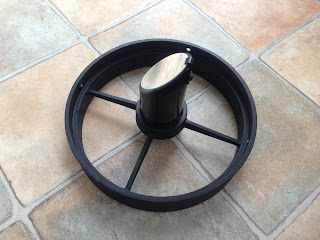 |
| Four screws hold the SkyWatcher 130M spider | SkyWatcher 130M (SK1309EQ2) secondary mirror |
By the time I finished, I realised it probably wasn't essential to remove the secondary like this, but it does make dealing with the four nuts at the other end of the tube easier! Once the four retaining screws in the curved side of the bottom piece are removed (again, taking take not to drop the nuts on the mirror), the whole mirror cell can be removed. This comes in two parts joined by the three collimation screws - separated by rubber 'O' rings (about 5mm as a pair):
I'd intended to follow the method on this thread moving the mirror of the SkyWatcher 130P, replacing the collimation screws with longer bolts, and the rubber 'O' rings with 2cm long compression springs (specifically the SC229 springs from www.strutdirect.co.uk). However, once I'd taken it apart I realised the SkyWatcher 130M has a differently mounted mirror.
Here is my schematic of the original arrangement (left) and how I moved the mirror up the tube (right) by about 3cm. The basic idea is to put the mirror mounting plate (shown in blue) above the mounting ring (shown in green), allowing enough room for the four nuts used to attach the ring to the main tube:
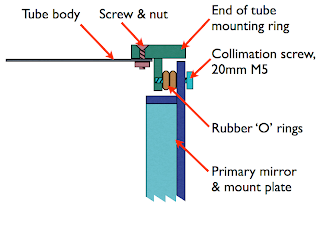 | 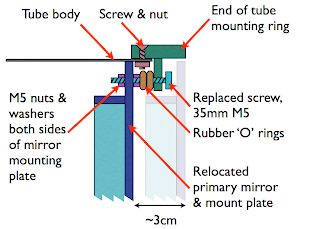 |
| Diagram showing SkyWatcher 130M (SK1309EQ2) primary mirror attachment. | Diagram showing modified SkyWatcher 130M primary mirror attachment, moving it about 3cm |
The collimation screws' holes in the mounting plate are not threaded (although the neighbouring lock screws do have threaded holes), so I have put washers either side of this in the hope that when I turn the new longer collimation screw (35mm M5 thread) in the threaded hole on the flange of the mounting ring this will move the mirror. We shall see.
Simply reusing the existing rubber 'O' rings seems to work (they are glued onto the flange so must be carefully peeled off in order to use them on the other side of the flange). A very short spring might work instead...
 |  |
| Replacement collimation screw with rubber 'O' ring, nut and washer ready for the mirror plate... | Reassembled mirror cell post modification, filing by yellow tape aligns to the main tube's seam. |
As my diagram tried to suggest, it is a pretty tight fit to get the mirror's mount disk inside the main tube. I had to file it down 1mm or so in places, and more at the seam of the tube. You can see this as the shiny edge in the photo above by the yellow marker tape - I may need some mat-black paint to cover this. Despite this, there is now a lot more light leaking into the end of the tube - a new cover might help?
And here's an exterior shot of the reassembled telescope tube - having moved the mirror like this makes it really quite easy to place the four nuts and bolts, but they do restrict the mirror placement - I've had to move it higher than I originally intended.
 |  |
| SkyWatcher 130M before modification, note the plate is flush with the ring. | SkyWatcher 130M after modification, note you can reach the ring nuts etc. |
You might notice that I've left the old collimation lock screws in place - I'm intending to try using them like this with fingers/pliers to turn them. It might work?
If this alternative mounting doesn't work that well in practise, I'm now less nervous about the simpler option of simply cutting an inch off the end of the tube itself. With a suitable saw I think that would actually be more straightforward (but irreversible).
I'm waiting for a clear night to test this out, and attempt to re-collimate the telescope. Fingers crossed for some nice astrophotography results with my Canon EOS DSLR directly attached. From some daylight testing it does seem like I will need an extension tube for some of my eyepieces now - I really should have ordered one before.
I'll direct any discussion to this thread on the StarGazersLounge.com forum.
Update (21 April)
I did get a chance to test the initial modification, and took a couple of photos of the Moon and Jupiter, but it was too windy to really examine the performance on stars. Comments on the this thread reinforced my worry about too many moving parts with the extra nuts, so I'm trying out an alternative arrangement using springs. The trick here is I've cut a slot into the end of the bolts which can then be turned from the outside with a flat screwdriver for collimation adjustments.
 | 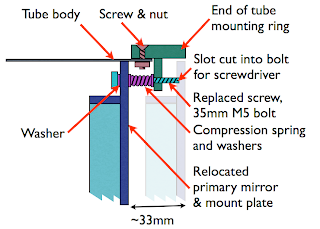 |
| Diagram showing SkyWatcher 130M (SK1309EQ2) primary mirror attachment (pre-modification) | Diagram of SkyWatcher 130M using springs for primary mirror attachment, moving it just over 3cm |
 | 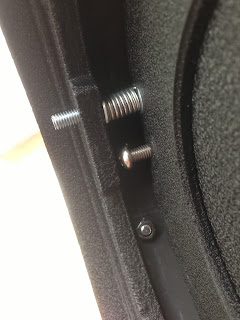 |
| Original SkyWatcher 130M modification re-using the rubber 'O' rings for the mirror | Revised SkyWatcher 130M modification using springs to mount the mirror |
Again, please post any discussion on this thread on the StarGazersLounge.com forum.

